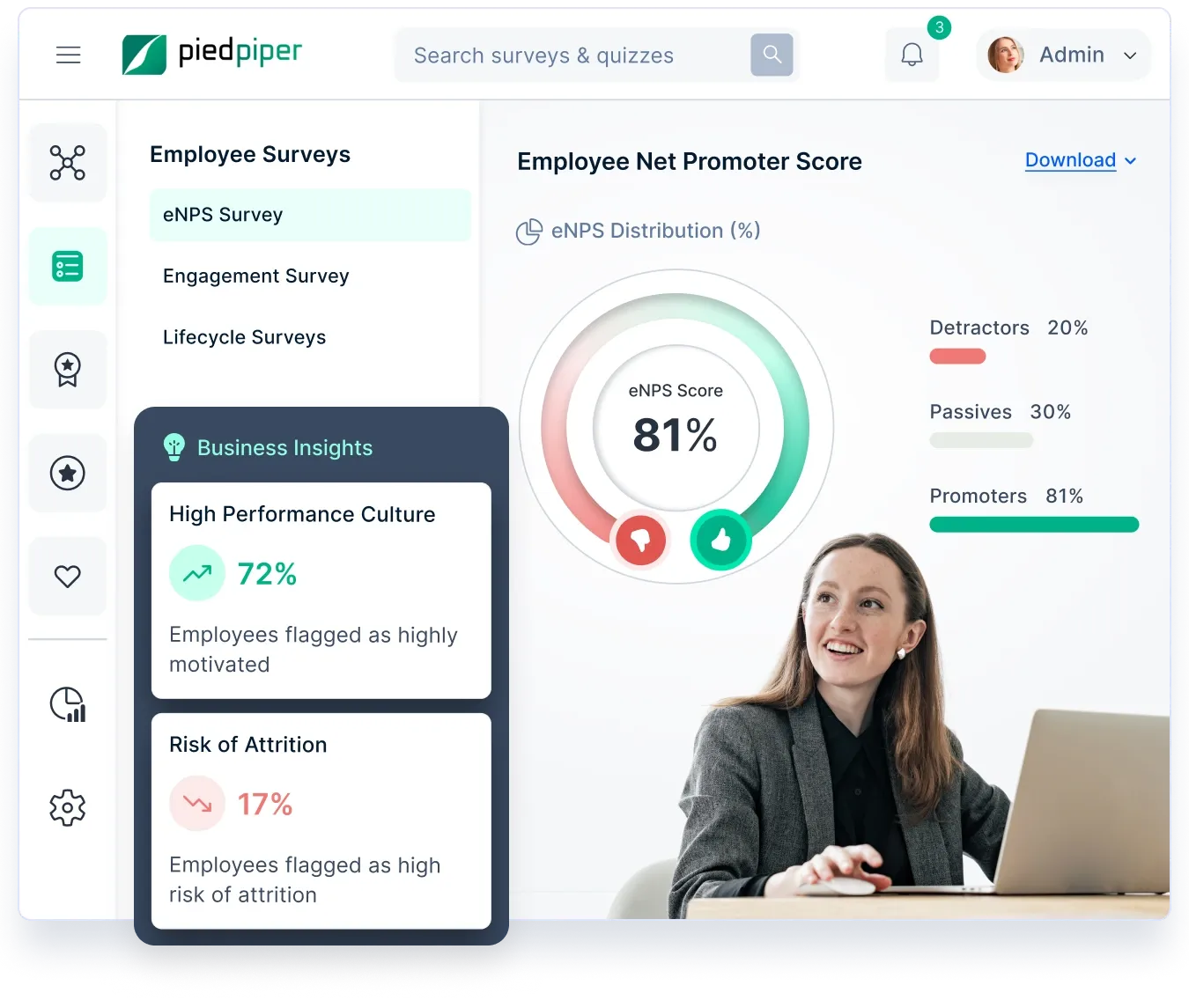Sondaggi sul coinvolgimento dei dipendenti: Come catturare un feedback autentico
Un sondaggio sul coinvolgimento dei dipendenti è uno strumento potente per comprendere il sentiment del luogo di lavoro e migliorare l'esperienza dei dipendenti. Ma la raccolta di feedback è solo il primo passo: sapere come comunicare efficacemente i risultati di un sondaggio sul coinvolgimento dei dipendenti garantisce che le intuizioni portino a un cambiamento reale.
In questa pagina
- Che cos'è un sondaggio sul coinvolgimento dei dipendenti?
- L'importanza dei sondaggi sul coinvolgimento dei dipendenti
- Indagine come metodo di raccolta dei dati
- Indicatori chiave del coinvolgimento dei dipendenti
- How to create and run an employee engagement survey that drives real change
- What should be done with the employee engagement survey results?
- Capture real employee sentiment with Empuls’ engagement surveys
- Punti di forza
- Domande frequenti
An employee engagement survey isn’t just about collecting feedback—it’s about understanding what truly motivates your workforce and turning insights into action. Simply gathering responses won’t drive change; the real value lies in employee engagement survey analysis and how the results are used to create a better workplace.
But here’s the challenge—surveys can backfire if employees feel their feedback disappears into a black hole. That’s why knowing how to communicate employee engagement survey results is just as important as the survey itself. Transparency, clear follow-ups, and real action based on feedback build trust and encourage employees to share honest opinions.
In this blog, we will walk you through not just designing a powerful employee engagement survey, but also decoding responses, sharing findings effectively, and making tangible improvements that boost morale, retention, and productivity. Because a survey isn’t just a tool—it’s a conversation that shapes the future of your workplace.
Che cos'è un sondaggio sul coinvolgimento dei dipendenti?
An employee engagement survey is a set of questions designed to gauge the engagement level of teams, departments, and the company overall. While the concept is simple, measuring engagement can be more complex than it seems.
Organizations use various methods—some rely on the Gallup Q12 (12 key questions), others conduct an in-depth annual survey, and many prefer shorter, more frequent pulse surveys like the employee net promoter score. All these methods aim to measure engagement, so choose one that fits your goals and budget.
Remember, engagement surveys differ from employee satisfaction surveys. An employee might be satisfied with their salary or location but still be disengaged if their work feels monotonous or overly controlled, which can negatively impact business performance.
L'importanza dei sondaggi sul coinvolgimento dei dipendenti
Employee engagement surveys provide a space where employees can communicate any concerns or issues, they have. It isn’t always possible to interact with their employers individually, especially in larger workspaces.
In questi casi, è facile che le preoccupazioni passino inosservate perché non c'è spazio per una comunicazione chiara. I sondaggi sono un ottimo modo per identificare e risolvere i problemi dei dipendenti.
Impegnandosi e utilizzando i feedback dei dipendenti, è possibile migliorare l'ambiente di lavoro per renderli più felici. In questo modo i dipendenti si sentiranno ascoltati, apprezzati e inclusi, fattori chiave per la soddisfazione sul lavoro.
Employee engagement surveys are a quick yet effective method of improving employee satisfaction. You can boost your business's productivity and success by conducting them and making improvements based on them.
Indagine come metodo di raccolta dei dati
Lo scopo principale delle indagini sul coinvolgimento dei dipendenti è quello di ottenere informazioni sulle opinioni, le motivazioni e le valutazioni delle persone, sullo stato del gruppo e sulla coscienza individuale.
I dati raccolti con i metodi di indagine esprimono le opinioni soggettive degli intervistati. Devono essere confrontati con informazioni di natura oggettiva, che devono essere sviluppate in altri modi.
The development of a research program should precede the survey, a clear definition of goals, objectives, concepts (categories of analysis), hypotheses, objects, and subjects, as well as research tools.
Each survey involves an ordered set of questions (a questionnaire) that serves to achieve the research goal, solve its problems, and prove or disprove a hypothesis.
The wording of the items must be carefully considered in many ways, but, above all, it must be used to fix categories of analysis.

Scarica i modelli di sondaggio gratuiti per migliorare l'esperienza dei dipendenti
Ottenete modelli di indagine precostituiti per misurare il coinvolgimento, raccogliere informazioni e migliorare la cultura dell'ambiente di lavoro. Trovate il modello giusto in pochi clic.
Indicatori chiave del coinvolgimento dei dipendenti
Ora che abbiamo capito cos'è un sondaggio sul coinvolgimento dei dipendenti, vediamo quali sono gli indicatori più importanti del coinvolgimento dei dipendenti? Potrebbero sorprendervi un po'!
1. Fiducia nella catena di comando
Supponiamo che i vostri dipendenti non si fidino delle informazioni che ricevono dal loro diretto responsabile, dal capo reparto o dai vertici dell'azienda.
In questo caso, cominceranno a sentire che non vengono trattati come adulti professionisti che vengono trattati con onestà.
Ricevere troppi giri di parole e doppi sensi dai livelli superiori può essere condiscendente o frustrante e diminuire l'impegno emotivo dell'organizzazione.
2. Riconoscimento frequente ed equo
I vostri dipendenti sanno quando hanno svolto un ottimo lavoro, che si tratti di un grande progetto o di un piccolo lavoro? State promuovendo questi comportamenti all'interno dell'organizzazione per far capire ai dipendenti che cosa si intende per successo e che il duro lavoro viene riconosciuto e premiato?
If you’re not, you’re missing out on a big driver of engagement. If your recognition strategy is based on a concept like “Employee of the Month,” where everyone is recognized similarly, no one will truly feel recognized.
Mantenere i premi personali e basati sulle prestazioni è una best practice approvata da SHRM.
3. Richiesta di feedback
Simply asking employees for their opinions in a thoughtful, purposeful way can slightly increase engagement.
Ai vostri dipendenti piace che venga chiesto loro cosa pensano della vita in azienda: questo dimostra che tenete in considerazione le loro opinioni e i loro feedback.
Naturalmente, per ottenere l'aumento di coinvolgimento che deriva dalla richiesta di feedback, è necessario mettere in atto i cambiamenti suggeriti dai dipendenti con una frequenza tale da dimostrare che si sta veramente ascoltando ciò che dicono. È qui che si rivela utile un piano d'azione post-sondaggio.
How to create and run an employee engagement survey that drives real change
A successful employee engagement survey isn’t just about collecting feedback—it’s about gathering insights that lead to measurable improvements. Many organizations struggle with engagement not because they lack data, but because their surveys fail to uncover real sentiment, key concerns, and actionable solutions.
To get meaningful, data-driven results, organizations must structure their surveys strategically. Here’s a step-by-step breakdown of how to create and run an engagement survey that drives real change—not just reports numbers.
1. Define a clear objective tied to business outcomes
Instead of vague goals like “measuring engagement,” link the survey to specific business challenges. Are you trying to reduce turnover? Improve leadership effectiveness? Identify productivity blockers? A well-defined objective helps frame the right questions and ensures that survey data translates into action.
2. Ask the right questions to uncover root causes
Many engagement surveys focus on surface-level indicators—job satisfaction, work-life balance, or leadership perception—but fail to dig deeper into the ‘why’. A powerful survey balances quantitative and qualitative questions to pinpoint areas that need attention.
- Instead of just asking, “Do you feel valued at work?”, follow up with “What specific actions from leadership make you feel valued?”
- Move beyond engagement scores by asking, “What barriers prevent you from being more engaged in your role?”
- Leverage Empuls employee engagement survey templates, which include structured questions designed to uncover actionable insights.
3. Ensure anonymity to encourage honest feedback
Employees hesitate to share critical feedback when they fear repercussions. Empuls ensures survey anonymity while providing HR teams with AI-driven insights, making it easier to identify trends without exposing individual responses.
Clearly communicate who will see the results, how data will be used, and how confidentiality is maintained. Without these reassurances, survey participation and honesty suffer.
4. Choose a survey cadence that fits your organization’s needs
- Quarterly pulse surveys are great for tracking ongoing engagement trends.
- Annual engagement surveys provide a comprehensive review but need fast action to stay relevant.
- Real-time sentiment analysis, like that offered by Empuls, helps HR teams detect engagement shifts instantly.
Organizations should balance frequency with actionability—too many surveys without follow-through lead to survey fatigue, while infrequent surveys fail to capture changing sentiments.
5. Drive participation with a strong internal campaign
A survey is only useful if employees take it. Instead of sending a generic email with a survey link, craft a clear, compelling message that answers:
- Why is this survey important?
- How will the company use the feedback?
- What changes have been made based on past surveys?
Consider using multiple touchpoints—emails, internal chats, leadership endorsements, and Empuls’ AI-driven notifications—to maximize participation.
6. Analyze survey results with a focus on trends, not just scores
Organizations often get caught up in benchmarking eNPS or engagement scores without analyzing why certain groups are more engaged than others. Break down survey responses by:
- Department or role: Are engagement issues concentrated in specific teams?
- Leadership levels: Do managers feel more disengaged than employees?
- Historical trends: How do this year’s scores compare to last year’s?
Empuls’ advanced analytics help organizations spot patterns, heatmaps, and sentiment trends, making it easier to pinpoint systemic issues rather than surface-level complaints.
7. Communicate results transparently to build trust
Knowing how to communicate employee engagement survey results is as important as collecting them. Employees want to see how their feedback drives change.
- Share high-level results in a town hall or internal newsletter.
- Focus on key themes rather than just numerical scores.
- Acknowledge areas needing improvement—employees appreciate honesty over sugarcoating.
Avoid vague responses like: “We appreciate your feedback and are working on improvements.” Instead, be specific: “Survey results indicate that employees seek more career growth opportunities. Over the next quarter, we are launching a mentorship program to address this.”
8. Take action and show visible improvements
A survey without follow-through erodes trust. Use survey data to implement targeted, visible improvements and communicate progress consistently. Some quick wins include:
- If employees feel underappreciated, introduce recognition programs via Empuls.
- If employees feel disconnected from leadership, hold monthly leadership Q&As.
- If employees lack growth opportunities, create clear career progression paths.
Regularly updating employees on how feedback translates into change ensures that future surveys receive higher participation and more honest responses.
9. Measure impact and continuously refine your survey approach
The real success of an employee engagement survey isn’t in the first report—it’s in the long-term impact on workplace culture. Track post-survey actions, conduct follow-ups, and assess whether changes have positively influenced engagement scores.
Use tools like Empuls to monitor engagement trends over time and adjust strategies accordingly. Engagement isn’t a one-time effort—it’s an ongoing conversation that requires data, action, and refinement.
What should be done with the employee engagement survey results?
So, what do you do next once you run your employee engagement survey - especially if you’re doing it for the first time? If you’ve designed a well-crafted and thoughtful survey, you’ll have plenty of data, statistics, and potential verbatim feedback to go through.
But if you think your work is now done - not yet! It’s just beginning. That’s because what you do with your employee engagement survey findings is the most important part of your survey process.
Ma non preoccupatevi: abbiamo pensato a come utilizzare i risultati del sondaggio sul coinvolgimento dei dipendenti e il piano d'azione. La guida completa alla stesura del piano d'azione post-sondaggio è qui.
Seguite queste regole per ottenere informazioni utili e prendere le giuste misure.
1. Agire in modo trasparente
Employees took time out of their busy workdays to provide thoughtful feedback on your survey - so what will you tell them when it’s over?
If your feedback is much more negative than you thought, it can be tempting to stuff the results in a drawer or server somewhere and hope everyone forgets about them. (Research shows that 20% of companies essentially do just that.)
But employees aren’t going to forget that easily - and it looks like you’re hiding the results, which erodes trust and engagement. So take a deep breath and thank employees for taking the time to take the survey.
Inizialmente si trattava di un'attività facoltativa a beneficio dell'azienda, non di loro, dopotutto. Ora è il momento di presentare un piano d'azione che dimostri ai dipendenti che partecipare al sondaggio è vantaggioso anche per loro, perché state ascoltando ciò che dicono e agendo in base ai loro feedback.
L'anno prossimo saranno ancora più propensi a partecipare al sondaggio e questo semplice atto di ascolto potrebbe aumentare i punteggi di engagement da solo.
2. Non raggruppare tutte le persone
It’s a best practice from the experts at SHRM - once your survey results are in, don’t just look at the data as a whole. Even for smaller companies, employees in different roles and departments will have very different experiences at work, and their engagement scores and factors likely look very different as well.
Analizzate invece i dati complessivi per individuare eventuali tendenze generali e poi continuate ad analizzare i raggruppamenti pertinenti. Ad esempio, per unità organizzative a livello di dipendenti e/o per risultati demografici. Osservare i dati in questo modo vi aiuterà a individuare meglio le tendenze più importanti.
For example, say you look at your engagement data and find low scores in one particular department. What’s going on? Well, check the data further. Is there a generational disconnect, with younger workers feeling less happy and more frustrated?
Or individual contributors are engaged, but the management level is not. Once you identify the gaps, you can start thinking about solutions.
3. Compiere azioni tangibili
Se fate un sondaggio ai dipendenti solo perché siete curiosi di sapere cosa ne pensano, ma le loro risposte di feedback riflessivo non portano ad alcun cambiamento effettivo, i dipendenti capiranno che non siete realmente interessati ad agire.
And then, they will stop providing real answers in upcoming surveys. Why should they share their thoughts, after all, if you’re not listening? That’s why sharing employee engagement survey results and action plans becomes crucial.
Dovreste prendere i dati appena raccolti dall'analisi e iniziare a decidere le modifiche da apportare come risultato. Non è necessario che questi cambiamenti siano enormi: possono essere semplici come eliminare un processo che i dipendenti trovano frustrante o rendere più facile per i manager riconoscere i dipendenti al momento con gli strumenti di riconoscimento giusti.
L'importante è fare qualcosa di significativo per dimostrare che avete ascoltato e che vi interessa.
4. Non lasciate che il difensivismo si metta di traverso.
Sebbene sentirsi un po' sulla difensiva possa essere una prima reazione naturale, se la vostra reazione emotiva a un feedback aperto e onesto vi impedisce di vedere effettivamente la necessità di apportare cambiamenti al vostro posto di lavoro, allora avete un problema.
Per ottenere informazioni utili dal sondaggio sul coinvolgimento dei dipendenti, è necessario impegnarsi ad accettare e agire sui feedback prima che il team HR e di leadership invii il sondaggio.
5. Comunicare in modo proattivo
Se ricevete molti feedback negativi, dovete apportare cambiamenti reali, ma questi cambiamenti possono richiedere tempo.
Va bene, purché comunichiate costantemente con i dipendenti ciò che avete sentito dire, quali cambiamenti apporterete e quando si aspetteranno di vedere e sentire tali cambiamenti.
I vostri dipendenti sanno che le cose richiedono tempo e vogliono sentirsi rassicurati che il loro feedback è stato ascoltato. Avere un solido piano di comunicazione per annunciare e condividere i risultati del sondaggio sul coinvolgimento dei dipendenti e i piani d'azione, ringraziare i dipendenti per aver dedicato del tempo a rispondere e far sapere loro cosa si sta facendo con i loro feedback è una parte essenziale del vostro piano post-sondaggio.
6. Non ossessionatevi con un solo numero
Sebbene i dati concreti siano importanti per analizzare i risultati di un sondaggio, concentrarsi troppo su un singolo dato è spesso controproducente.
Quando il coinvolgimento dei dipendenti è molto più grande di un singolo problema, può portare a sforzi superficiali per aumentare quel singolo elemento di coinvolgimento.
At AT&T, for example, executives give them trends and verbatim feedback from their most recent pulse surveys instead of giving line managers and supervisors access to scores. This focuses on the root causes of issues instead of targeting a single number to fixate on.
7. Continuare a sottoporre i dipendenti a sondaggi regolari
Sebbene sia possibile ricavare informazioni interessanti da un sondaggio una volta sola, si otterranno molte più informazioni se si effettuano sondaggi costanti tra i dipendenti, in modo da poter monitorare le tendenze e i progressi nel tempo.
This might mean committing to a large annual survey or adding in targeted pulse surveys like the ones in the Empuls platform so you can get feedback in real-time. Whatever your preference, be sure you keep at it.
Anche se all'inizio potrebbe essere difficile per la vostra organizzazione recepire i feedback e apportare modifiche, con il tempo ne raccoglierete i frutti.
Capture real employee sentiment with Empuls’ engagement surveys

Employee engagement isn't just about job satisfaction—it’s about creating a work environment where employees feel valued, motivated, and aligned with business goals. Empuls employee engagement surveys help organizations measure workplace sentiment, identify challenges, and implement meaningful improvements to enhance the employee experience.
With AI-driven analytics and real-time sentiment tracking, Empuls makes it easier to listen to employees and act on feedback. By capturing insights at every stage of the employee journey, businesses can create a workplace that fosters trust, collaboration, and high performance.
Why choose Empuls employee engagement surveys?
1. Measure engagement in real-time.
Traditional surveys provide delayed insights, but Empuls offers instant sentiment analysis through pulse and engagement surveys. Get real-time data on employee motivation, morale, and workplace culture to make quick, informed decisions.
2. Capture feedback at every stage
Employee experiences evolve over time, and so should your surveys. Empuls offers lifecycle surveys, tracking engagement from onboarding to exit. This ensures organizations understand employee needs at key touchpoints, improving retention and satisfaction.
3. Personalized, AI-driven conversations
Static surveys don’t always capture genuine feedback. Empuls uses AI-powered, adaptive conversations to engage employees in meaningful discussions. This helps uncover deeper insights into what truly matters to your workforce.
4. Customizable surveys for targeted insights
Every workplace is different, so Empuls allows businesses to customize surveys based on specific engagement challenges. With a rich question bank and flexible templates, organizations can tailor surveys to focus on leadership, work-life balance, recognition, or any other key area.
5. Data-backed decisions for meaningful change
Survey results are only useful when translated into action. Empuls provides AI-powered analytics, heatmaps, and benchmarking tools to identify trends and problem areas. This enables leadership teams to implement targeted improvements that drive engagement and business success.
ANCA’s journey to transform employee engagement with Empuls
ANCA Machine Tools, a global leader in CNC machines with over 1,000 employees, faced challenges with its rewards and recognition (R&R) processes. The existing system lacked consistency, transparency, and efficiency, leading to disengagement and a need for a more structured approach to boost employee morale.
La soluzione
After evaluating various options, ANCA adopted Empuls for its seamless features tailored to their needs. The platform's reward automation simplified the process, and its extensive redemption catalog offered employees meaningful choices. Empuls’ user-friendly interface ensured an effortless transition for the HR team and employees alike.
The Results
Empuls transformed ANCA's employee engagement with remarkable outcomes:
- 90% reduction in time spent managing rewards: Automation allowed the HR team to preset criteria, ensuring automatic point allocation with minimal effort.
- 100% increase in engagement scores: Consistent and transparent R&R processes fostered a stronger sense of value among employees.
- 80% employee satisfaction with the platform: Employees appreciated the ability to choose from a diverse catalog, reinforcing their motivation and loyalty.
A Satisfied Partnership
Rukmini Divakar, HR Manager - Asia at ANCA, praised the platform, saying: "We didn’t evaluate anybody else because Empuls gave us exactly what we wanted. The team presented how it works, and I only had to coordinate with one point of contact. The rest was taken care of."
Empuls transforms employee insights into actionable strategies, helping businesses foster a culture of transparency, recognition, and continuous improvement. Ready to build an engaged and motivated workforce? 👉 Explore Empuls employee engagement surveys today.
Punti di forza
Ci sono molte cose da sapere sui sondaggi sul coinvolgimento dei dipendenti: perché sono importanti, come farli correttamente e cosa significano veramente per la vostra azienda.
This guide has given you a starting point to measure employee engagement levels.
The first step towards raising your engagement rate is knowing where your company stands right now - that’s why you need to start creating your employee engagement survey today if you haven’t already.
Domande frequenti
1.What is employee engagement survey analysis?
Employee engagement survey analysis involves reviewing and interpreting survey responses to gauge how engaged employees are. This process helps identify strengths, areas for improvement, and trends over time to inform strategies for boosting engagement.
2.How are employee engagement scores determined?
Employee engagement scores are numerical values derived from survey responses that reflect various aspects of employee sentiment, such as job satisfaction, commitment, and morale. These scores provide a measurable way to track engagement levels and monitor changes over time.
3.How do I communicate employee engagement survey results?
Results should be shared clearly and transparently. Consider presenting key findings in a concise report or presentation that highlights both strengths and areas for improvement. Follow up with action plans and invite feedback to ensure employees feel heard and involved.
4.What are good questions for an employee engagement survey?
Good survey questions cover different dimensions of the employee experience, including job satisfaction, team dynamics, managerial support, growth opportunities, and work-life balance. The goal is to ask clear, actionable questions that provide insight into both what’s working well and what can be improved.
5.What is Empuls and how can it support employee engagement?
Empuls is an employee engagement platform that helps enhance workplace culture by offering tools for collecting feedback, recognizing achievements, and managing rewards. Its integrated survey features make it easier to measure and improve employee engagement effectively.













